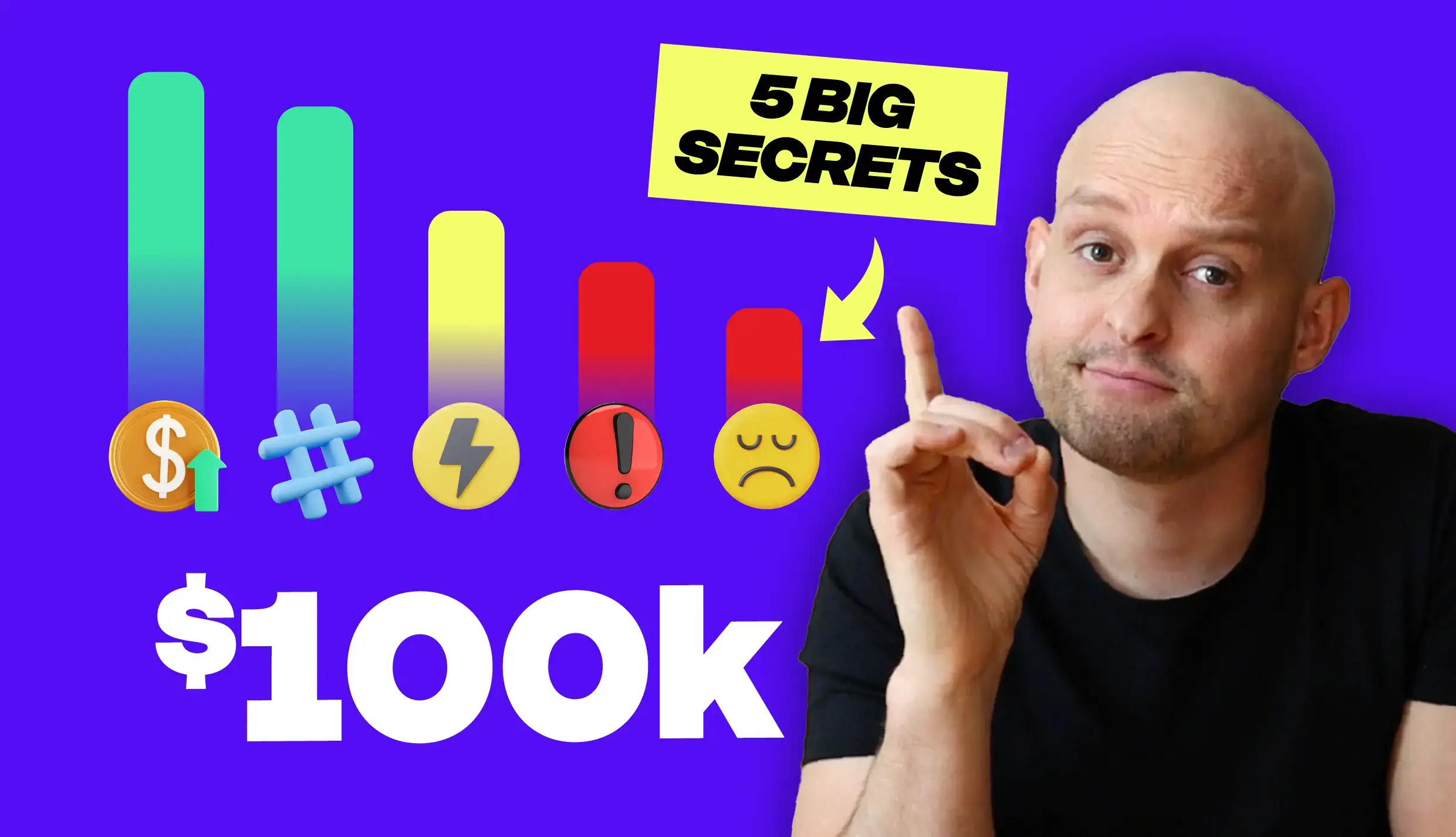We understand that things happen and situations change, but we hope you had a good experience with us!
Unfortunately, once a member leaves you can no longer reapply to join again down the road.
Are you sure you want to leave us?
.svg)
Secrets to Six-Figure Freelancing
Learn the framework to earning $100,000+ as a freelance web designer.

Intro
Disclaimer up front:
- Money doesn't equal happiness
- All the importance should not just be on what you’re earning
- But that being said... money can mean security, peace of mind, experiences, and more
What we’ll cover in this training
- Math of earning six figures
- Creating a clear vision of success
- Establish habits to track your progress
- Help you build an ironclad business model
- Increasing efficiency and outsourcing
- Execution, momentum and patience
You might ask yourself:
- What about just getting more clients to earn more money? Shouldn’t I just focus on getting more clients?
- Instead, ask yourself: are you not earning six figures because you don’t have enough clients… or is it because you’re not putting in place the systems of a six figure caliber designer?
Math of Earning Six Figures
Variables to consider:
- Profit per project (PPP): how much money goes into your pocket after you’re done with each project
- Quantity: how many projects can I manage at the same time? What’s the turnaround time?
- Input: how much time goes into each project, e.g. how much of your time, your energy and your team’s time goes into each project?
- Risk: how much risk do I face? Too much riding on a single client? Am I at risk of burnout, low results, maintenance or unforeseen issues?
- Difficulty: how feasible is it to accomplish all of these things? Is it very likely that I can land one six-figure client each year? Can I manage 250 clients at once? Probably not!
Let’s explore five possible scenarios:
Scenario #1
- Freelancers that are charging a lot for their projects, so they have high PPP, but are not able to land a lot of high value projects.
- High risk because if one client cancels you lose a lot of your revenue
- Hard to sustain
Scenario #2
- Freelancers landing a lot of clients each month, low PPP, but high quantity, lots of input
- Risk is very high because high risk of issues with high quantity of clients
Scenario #3
- Freelancers with high PPP, but have to put lot of input into each project, and it’s not sustainable because of that
Scenario #4
- This is the scenario we want to achieve as soon as possible: balance!
- Charging a reasonable rate
- Have a high variety of different types and budgets of clients, so risk and difficulty is manageable
Scenario #5
- Once you’ve achieved #4 Scenario, you are ready for this scenario.
- From here you can begin to increase your profits because you have systematized, automated and built out a team.
Goals - Creating a Clear Vision of Success and Establishing Habits to Track Your Progress
- Without setting good, high-quality, and actionable goals, you’re not going to be able to accomplish this goal of being a high earning designer.
- But it’s important to remember… goals don’t get you there - habits do!
- “Don’t expect to be motivated every day. You won’t be. Don’t count on motivation… Count on discipline.” - Jacko Willink
- Don’t rely only on your motivation and ambition. Only those that are disciplined and set daily habits accomplish their goals.
How to turn your goals into habits:
- Example: Turn a goal of “I want to lose 20lbs this year” into habits that help you get to those goals:
- Take at least one step on the treadmill every day
- Walk 5,000 steps per day
- Don’t drink soda on the weekdays
- Set a reminder on my phone to drink water every hour
Turn a goal of earning $100k this year into:
- Wake up at 6:30am every morning
- Shut off notifications for at least 2 hours of deep work
- Hire a designer on a per project basis by next month
- Never take on a project less than $10,000
- Create 1 piece of social media content every day
- Add one new portfolio piece (case study) every month
- Spend every Monday morning planning my entire week around 1 goal
- Spend 30 minutes every day learning SEO
Set a CRUX Habit
- Crux: vital, basic, decisive or pivotal point
- A Crux Habit is one single habit that will have the greeted effect on all other goals or habits
- My example of a Crux habit is going to sleep at 11pm. Having this crux habit helps fuel all of my other good habits.
Goals and Habits Worksheet
- Helpful worksheet you can use to set your goals and find the habits to help you achieve your goals
- Also you can pick and commit to your Crux Habit
- Use this time between now and the end of the year to put these habits to work. Then by the time the new year rolls around you can have these habits already implemented and in place
- Don’t forget: money, duty, necessity and external pressures can’t carry you through… but passion will.
Helping You Build an Ironclad Business Model
Freelance Web Design Business Model Worksheet
- We strongly encourage you to to go through this worksheet to help create an ironclad business model for your freelance business
- Link to the spreadsheet is available in your dashboard
Component #1: Revenue Model
- First thing to write down is your value proposition, positioning and messaging: these will help you to clarify why a customer should go with your business over any other
- For example, Pait Pro’s value proposition is getting everything in one place. Our positioning is that we have a unique combination of skills (Webflow, SEO and Site Migrations) that is exactly what a specific niche of customers are looking for. Our messaging is trying to convince prospective clients that we are well equipped to take on their Webflow project because of our additional skills. Our strategic advantage is that we have all of the skills to take care of them in one place, and that sets us apart.
Secondly, write down your sales history
- Include your last 10 client projects. Evaluate where people are finding you and how is that affected buy your positioning and messaging
Third, explore your revenue Model
- Most six-figure freelancers don’t just have one revenue stream
- Reflect on other ways you can diversify your income
- Forecast your coming months revenue
Fourth, investigate any potential roadblocks
Component #2: Gross Margin Model
- List out all of your expenses and unforeseen expenses to determine your gross margin model
- Keep your margins in mind anytime you adjust your pricing and expenses
- What is needed to hit six figures, e.g. how many projects do you need to land? What is needed to land them?
- Final question is some self reflection to determine what needs to be done to hit your revenue goals
Component #3: Operating Model
- Write out all of the roles and responsibilities in your business, all of the input that goes into your projects
- Write out all of your systems and processes that you have in place, unearth those times and opportunities you can use to cut time and cost to be more efficient
- What opportunities are there to cut turnaround time by 25%?
- What are the top three tasks that you will outsource first?
- Are there any major issues that are hurting your turnaround time or quality of your projects?
Component #4: Working Capital Model
- As freelancers we don’t typically require any working capital to operate our business
- However, how can you leverage your extra cash to reinvest in your business?
- Don’t put every dime of your profits in your pocket - invest back in your business!
Component #5: Sales Model
- Great idea to go over this exercise every year, if not every quarter
- List your current active outreach method
- List your outgoing content creation methods
- How many sales or strategy calls do you take per month?
- List any additional marketing that you’re doing
Increasing Efficiency and Outsourcing
First thing you need to learn to do is actively ignore tasks and responsibilities that will not grow your business. Examples of things that may not grow your business:
- Emails
- Client requests
- Brand website and company ethics
- Fulfillment - need to prioritize the growth of your business, before your clients. At the end of the day, if you don’t prioritize your business you’re going to go out of business and won’t be able to serve your clients, so be sure to focus on your business
Instead, you should be focusing on:
- Outreach
- Hiring
- Messaging
- Systematizing
- You must guard your own time
The next question you need to ask yourself is if you’re not working, is your business still growing?
- We need to put things, systems and people in place that work while we’re not working
For example:
- Content
- Website
- Ads
- Employees
- Investments
- Reputation
- Referrals
- Automations
- Recurring contracts and subscriptions
Make plans to build a system that functions without you
Answering Some Questions From the Group
How can you make great content that generates leads and grows awareness?
- ALL content is great content
- The more the merrier (repurpose across all platforms)
- It takes time to get good at creating content, but it is probably the most valuable skill you can learn.
- Don’t hold off on creating content because you’re worried it won’t be good enough, just get started!
- Buy back your time then make sure you use it on something more impactful for your business
- When you pay for employees, automations, etc., make sure you find the time you’ve now saved to do something impactful for your business
What are some tips for hiring and outsourcing?
Give up the tasks that:
- Take the most time
- Use the most mental energy
- Cause the most stress
- Are the weak point in quality
Where to hire:
- Facebook groups
- Fiverr
- Upwork
How to hire:
- Simple per project agreement
- Draft a simple agreement within your contract software
- We use Hello Bonsai
How to interview:
- Write out role requirements and responsibilities
- Zoom call
- Pick the candidate you feel would be easiest to work with and is more qualified
How to pay:
- Venmo
- PayPal
- Wise
- For full time employees we use ADP
When should you begin scaling and how to begin?
- First question to ask yourself is why do I want to scale?
- There isn't one moment to start scaling - you should always be scaling!
- Always be bringing on new partners, trying new tools and introducing new automations
- Don’t wait until it’s too late and you’re at 120% capacity - do it too early if necessary!
- Hire someone at a minimal position and rate today
How do you vet prospective hires
- Determine what is the most important to you (productivity, responsiveness, exceptional talent, great communicator)
- Know exactly what you’re looking for (be precise)
Example; don’t just say “I want someone who is efficient”
- Say “I want someone who can draft up a homepage in Figma in 20 minutes to show clients quickly”
What are some tools for business management, project management and automation?
- Notion
- Slack
- Asana
- Zapier
- Virtual assistant
Execution, Momentum and Patience
- As you learn to execute, you build up momentum, and then you can move swiftly to accomplish things at greater pace in your business
- “If I only had an hour to chop down a tree, I would spend the first 45 minutes sharpening my ax.” - Abraham Lincoln
- I’ve found that the more time I spend planning for my business, the more effective I can be
- Never start your day or week without a clear plan of attack
- If you run out of things to do and start spinning your wheels, stop working completely and go back to making a plan
- Stop hunting, start cultivating
- Do you really want to go out on a vicious and risky-hunt every time you get hungry? No!
- Instead, prepare for the future and cultivate a predictable system to feed yourself and your family
- By cultivating a system that works on its own, your levels of anxiety can decrease, and you can build a predictable and consistent life for your family
So focus on…
- Building evergreen content
- Focusing on your reputation
- Building a strong portfolio
- Think of this as a long-term commitment
- Carefully plan and prepare
- Focus on calculated pricing and execution
- Create multiple methods of lead generation and income
Action Items Moving Forward
- Set aside 1 hour to go through the Goals and Habits worksheet (template can be found in your dashboard)
- Post your CRUX habit in the Facebook group
- Work through the business model worksheet


